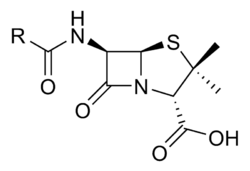Penicillins
| This article has been peer reviewed but is awaiting expert review. If you would like to help with this, please see more information about expert reviewing. |
|
|
Mechanism of Action
Penicillins are β-Lactam antibiotics. This means that they interfere with the synthesis of peptidoglycan, a crucial component of the bacterial cell wall. Penicillins bind to proteins on the bacteria and then inhibit a transpeptidation enzyme, whose role is to cross-link peptides attached to the peptiglycan backbone. This weakens the bacterial cell wall integrity.
The penicillins also inactivate an inhibitor of autolytic enzymes present in the cell wall, thus resulting in lysis of the bacterium.
Due to the lytic nature of the group of drugs they are considered to be bacteriocidal (ie kill bacteria) and time dependent killers.
Spectrum of Activity
Over the years different sub-groups of Penicillins have been developed; this is because many bacteria have developed beta-lactamases which will therefore reduce the action of the antibiotic.
Natural Penicillins - benzylpenicillin or Penicillin G
- Narrow spectrum of activity.
- Active against gram positive organisms, except beta-lactamase producing Staphylococci.
- Active against many obligate anaerobes.
Anti-staphylococcal / IsoxazoylPenicillins - Cloxacillin
- Narrow Spectrum
- Resistant to beta-lactamase producing Staphylococci, and so active against gram positive bacteria.
- Active against many obligate anaerobes.
Aminopenicillins - Amoxycillin
- Broader spectrum than the above penicillins.
- Active against gram positive species except those with beta-lactamase enzymes.
- Active against some gram negatives but not any of the hardier species.
- Active against many obligate anaerobes.
Extended Spectrum Penicillins / Carboxypenicillins - Ticarcillin
- Broad Spectrum
- Active againts gram positive species except those with beta-lactamase enzymes.
- Active against gram negatives including the hardier species, such as Pseudomonas aeruginosa.
- Active against many obligate anaerobes.
If a beta-lactamase inhibitor (Clavulanic acid) is added to the drug formulation, the spectrum of most sub-groups is extended.
Pharmacokinetic Considerations
All the sub-groups behave in the same way pharacokinetically.
They are organic acids, hydrophilic and will ionise at physiological pH. They generally have poor oral bioavailability as they unstable in acid environments. They have a limited volume of distribution (0.2-0.3l/kg), this means the drug is mainly confined to plasma and interstitial space. As the are hydrophilic they can't enter cells and won't cross the blood brain barrier, unless it is damaged. They have short half-lives of about 0.5 - 1.2 hours. They are readily excreted by the kidneys, via tubular secretion in the proximal convoluted tubule. This results in high concentrations of the drug in urine.
- Natural Penicillins - unstable in acid. Usual routes of administration: IM, SC and Intramammary
- Isoxazoyl Penicillins - stable in acid, except methicillin. Food greatly reduces absorption. Routes of admin: PO, IM, IV. Cloxacillin and nafcillin are found in some intramammary preparations.
- Aminopenicillins - stable in acid, though bioavailability is reduced by food. Routes of admin: IM, SC, IV, PO and intramammary.
- Carboxypenicillins - unstable in acid. Route of admin: IM or IV.
Side Effects and Contraindications
This group of antibiotics on the whole are very safe.
- It has been known to cause acute anaphylaxis or mild hypersensitive reactions.
- High intravenous doses can lead to platelet dysfunction.
- Penicillins containing procaine musn't be given I.V. or with sulphonamides (they antagonise the action of sulphonamides.)
- Care must be taken when giving narrow spectrum penicillins to Guinea Pigs, Rabbits, Gerbils, Hamsters and Chinchillas as they can result in fatal Clostridium difficile colitis.
